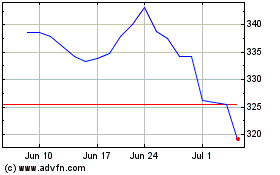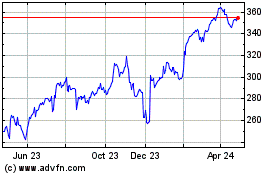Economist Intelligence Unit Survey, Sponsored by Cigna, Reveals Americans’ Views on Opioid Addiction
September 20 2017 - 3:48PM
Business Wire
- Fewer than half of U.S. general public
think opioid addiction is treatable
- Veterans are particularly complex to
treat, says 70 percent of medical practitioners
- Medical practitioners would welcome
more resources to treat veterans with opioid addiction
- Online hub launched today with in-depth
survey analysis
The Economist Intelligence Unit (EIU) and Cigna (NYSE: CI) today
launched an online hub with survey findings on how U.S. medical and
addiction practitioners and members of the American general public,
including veterans, view opioid addiction and the best ways to
treat it.
The research comes at a time when more than 33,000 Americans a
year die from opioid-related overdoses.1 In the U.S., the total
economic burden from opioid misuse hit an estimated $78.5 billion,2
a number that reflects the cost to the U.S. economy as well as the
impact the crisis has on families in lost jobs and lost wages.
Cigna commissioned the survey as part of its continuing
commitment in helping to curb the national opioid epidemic, with
special emphasis on veterans, who often struggle with pain,
post-traumatic stress disorder, depression and other health
conditions, as well as challenges transitioning back to civilian
life. The number of veterans living with opioid issues grew 55
percent between 2010 and 2015.3 Between higher rates of chronic
pain4 and a 270 percent spike in opioid prescriptions over a
12-year period,5 veterans are twice as likely to die from
accidental opioid overdoses than non-veterans.6
“We know we can and must do more as a society. That’s why this
report is so important as we fight this crisis. Ultimately, we hope
it can contribute to the beginning of the end of opioid misuse
across America,” said Cigna President and CEO David M. Cordani.
Among key findings, the survey revealed that only 47 percent of
the U.S. general public – less than half – think opioid addiction
is treatable, compared to 70 percent of medical practitioners. Both
groups say that treating veterans who suffer from opioid addiction
is more complex than treating others who suffer from opioid
addiction.
More than a third of medical practitioners say they are not very
confident they have the right resources and training to treat
veterans living with opioid addiction. The survey also found that
43 percent of medical practitioners cited overprescribing as a
cause of addiction, but 58 percent said they focus more on treating
the patient’s condition than the potential for opioid misuse at the
moment of prescribing. Thirty-two percent of veterans cited
encouraging the medical community to prescribe less addictive
painkillers as an effective way to reduce the supply of opioids to
the general public.
The surveys were finalized in July 2017 and include 304 medical
and addiction practitioners (70 percent who have treated veterans)
and 2,800 Americans, 21 percent of whom are veterans. Compilation
and analysis of results took place throughout August 2017.
The online hub includes an interactive map exploring the
treatment options the U.S. general public would like to see greater
access to, and points to case studies of successful programs across
the nation. The online resource also includes an executive summary
and briefing paper that provides an in-depth analysis of the
recently completed survey and includes a section dedicated to
veterans, including an executive summary focused on
veteran-specific responses.
“Cigna is optimistic that this is a challenge we as a country
can overcome – by working together. The intelligence we gained from
the EIU study is important because it points to where there are
gaps to be narrowed, and how we may begin to address them. It will
help us come together and know how best to work toward our common
goal,” Cordani said.
Among steps Cigna is taking to reverse the epidemic, the company
last year committed to reducing its customers’ opioid use by 25
percent over three years. In July, Cigna hosted a forum with Roll
Call in Washington, D.C., attended by government officials and
thought leaders to discuss current legislative efforts and programs
to fight this epidemic. Cigna also is collaborating with the
American Society of Addiction Medicine (ASAM) to help transform the
current treatment model based on best practices that are
prevention-focused, and the company lifted preauthorization for
medication-assisted treatment, an evidence-based intervention.
Additionally, in July 2017 the Cigna Foundation made a
three-year grant of $300,000 to the Iraq and Afghanistan Veterans
of America (IAVA) to help expand its Rapid Response Referral
Program, a community effort to help veterans meet their life goals
through connections to education, medical and legal resources and
benefits. Later this fall, Cigna will be announcing other support
for veterans and for health care professionals who treat
veterans.
For more information on Cigna’s leadership in addressing the
country’s opioid crisis, please visit here.
About Cigna
Cigna Corporation (NYSE: CI) is a global health service company
dedicated to helping people improve their health, well-being and
sense of security. All products and services are provided
exclusively by or through operating subsidiaries of Cigna
Corporation, including Connecticut General Life Insurance Company,
Cigna Health and Life Insurance Company, Life Insurance Company of
North America and Cigna Life Insurance Company of New York. Such
products and services include an integrated suite of health
services, such as medical, dental, behavioral health, pharmacy,
vision, supplemental benefits, and other related products including
group life, accident and disability insurance. Cigna maintains
sales capability in 30 countries and jurisdictions, and has more
than 95 million customer relationships throughout the world. To
learn more about Cigna®, including links to follow us on Facebook
or Twitter, visit www.cigna.com.
1 https://www.hhs.gov/opioids/about-the-epidemic/index.html
2 Florence, Curtis S. PhD; Zhou, Chao PhD; Luo, Feijun PhD; Xu,
Likang MD. “The Economic Burden of Prescription Opioid Overdose,
Abuse, and Dependence in the United States, 2013.” (Medical Care:
October 2016 - Volume 54 - Issue 10 - p 901–906). West Chester, PA.
Available online at:
http://journals.lww.com/lww-medicalcare/Abstract/2016/10000/The_Economic_Burden_of_Prescription_Opioid.2.aspx
3
http://www.pbs.org/wgbh/frontline/article/veterans-face-greater-risks-amid-opioid-crisis/
4
http://www.pbs.org/wgbh/frontline/article/veterans-face-greater-risks-amid-opioid-crisis/
5
http://www.pbs.org/wgbh/frontline/article/veterans-face-greater-risks-amid-opioid-crisis/
6
http://www.pbs.org/wgbh/frontline/article/veterans-face-greater-risks-amid-opioid-crisis/
View source
version on businesswire.com: http://www.businesswire.com/news/home/20170920006262/en/
Cigna CorporationGloria Barone,
215-761-4758Gloria.Barone@cigna.com
Cigna (NYSE:CI)
Historical Stock Chart
From Aug 2024 to Sep 2024

Cigna (NYSE:CI)
Historical Stock Chart
From Sep 2023 to Sep 2024
